Philippa Gregory's Blog: Philippa Gregory's News
October 7, 2022
Dawnlands pre-order bonus

I know some of you can’t wait to read the next instalment so my publishers are offering a sneak peek of my new novel Dawnlands to everyone that has pre-ordered it. Submit your receipt for either a hardback, ebook, or audiobook purchase and you’ll receive an exclusive excerpt emailed directly to you.
Head to the links below to find out more - you have until 7 November at 11.59PM GMT to submit.
UK | USA | AUZ/NZ | Canada
Published on October 07, 2022 05:57
•
Tags:
dawnlands
October 3, 2022
Dawnlands book tour
I’m pleased to announce I will be doing a short book tour for my new novel
Dawnlands
with some online events for my international readers. Find all the info at this link...
https://www.philippagregory.com/news/dawnlands-book-tour

https://www.philippagregory.com/news/dawnlands-book-tour

September 7, 2022
Barnes and Noble Dawnlands preorder offer [US]
August 25, 2022
10 Years since discovery of Richard III's remains
It has been 10 years since the discovery of Richard III’s remains underneath a car park in Leicester. As luck would have it, I was on a book tour for my novel The Kingmaker’s Daughter, a book about Richard’s wife Anne Neville, when the news broke that remains had been found during the search for Richard’s body.
Of course, it would be a few nail-biting weeks before formal identification, but the very possibility that a 21st Century team of archaeologists had found a lost royal tomb was fascinating for all of us who have an interest in medieval history.
For those of us who cannot help but admire Richard, the knowledge that his body was found and could be laid to rest really mattered, though I had no idea that I would find the service of re-interment so deeply moving. I contributed to the TV programme in the week before, and it became clear that we were talking about something which spoke powerfully to the people of England, and especially those of Leicestershire. On the day of the interment, I took my seat in the cathedral and watched the coffin come in, and the gentleman beside me bowed his head and said quietly: 'God bless and keep your Grace.’ It was an astounding moment, as if time itself had frozen: there was I, and so many others, at the interment of a medieval king.
Thinking about Richard and his reputation - horribly slandered by the winners who write the history - inspired me to write a play of my own. It’s my first stage play and I hope very much that it will be in production next year. It’s a tribute to a king who served England with loyalty - the virtue he quoted in his own motto.
Image: King Richard III, by unknown artist, late 16th century, NPG 148, © National Portrait Gallery, London
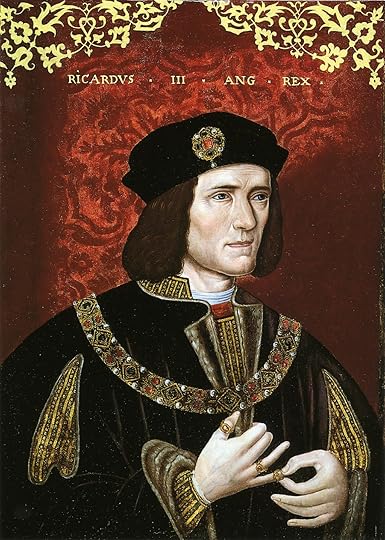
Of course, it would be a few nail-biting weeks before formal identification, but the very possibility that a 21st Century team of archaeologists had found a lost royal tomb was fascinating for all of us who have an interest in medieval history.
For those of us who cannot help but admire Richard, the knowledge that his body was found and could be laid to rest really mattered, though I had no idea that I would find the service of re-interment so deeply moving. I contributed to the TV programme in the week before, and it became clear that we were talking about something which spoke powerfully to the people of England, and especially those of Leicestershire. On the day of the interment, I took my seat in the cathedral and watched the coffin come in, and the gentleman beside me bowed his head and said quietly: 'God bless and keep your Grace.’ It was an astounding moment, as if time itself had frozen: there was I, and so many others, at the interment of a medieval king.
Thinking about Richard and his reputation - horribly slandered by the winners who write the history - inspired me to write a play of my own. It’s my first stage play and I hope very much that it will be in production next year. It’s a tribute to a king who served England with loyalty - the virtue he quoted in his own motto.
Image: King Richard III, by unknown artist, late 16th century, NPG 148, © National Portrait Gallery, London

Published on August 25, 2022 07:49
August 8, 2022
World Cat Day
You might think that the Internet invented cat pictures, but in truth, cats have appeared in art since they decided they would tolerate being around us. Cats appear as hunters, as pampered pets, and at differing times in history as symbols of lust or betrayal, of witchcraft and the nature of women, or even of fertility and domesticity.
So to celebrate World Cat Day, here’s a selection of cat pictures you might not have seen before…
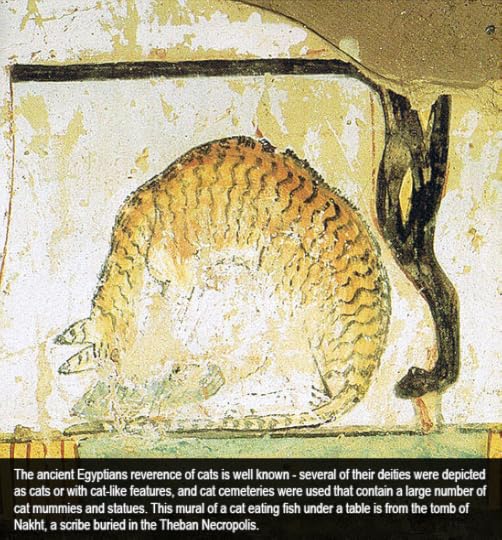
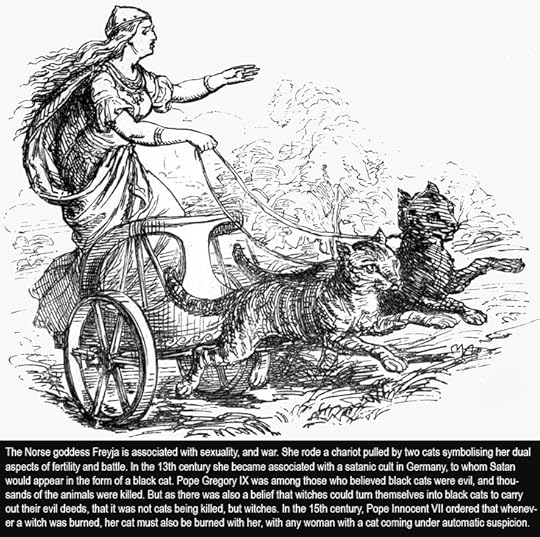
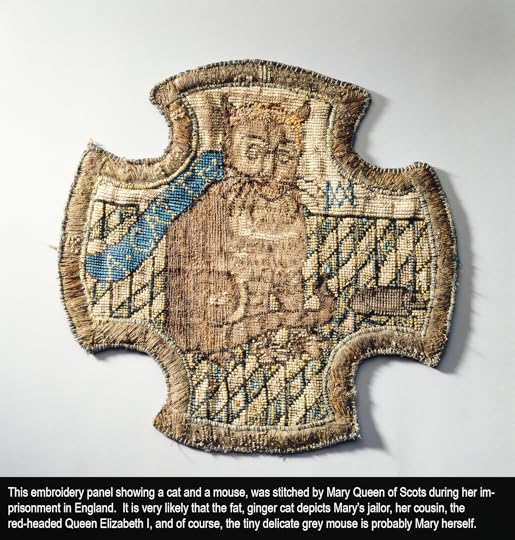
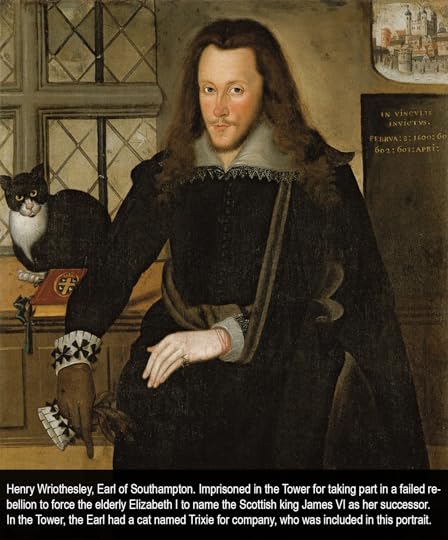
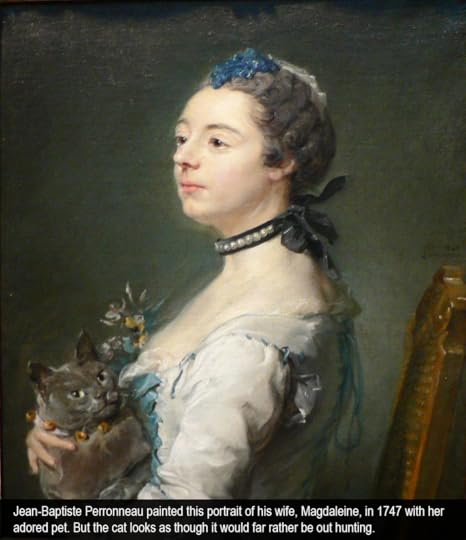
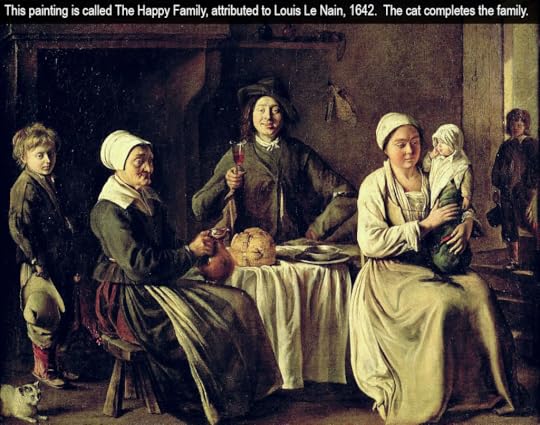
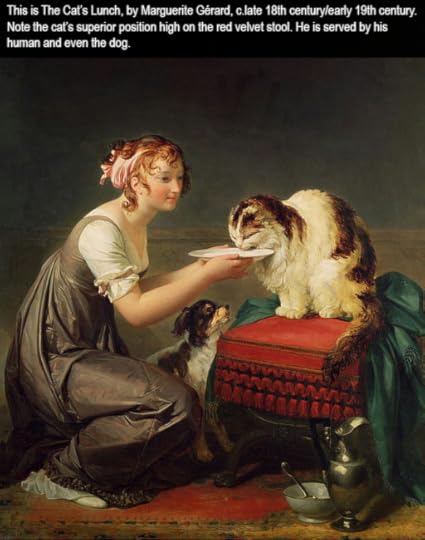

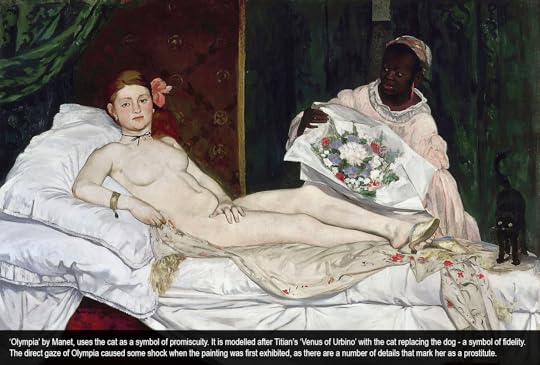
Images: Mural of a cat eating fish under a chair from the tomb of Nakht, 15th century BC, copied by Norman de Garis Davies, via Wikimedia Commons.
The goddess Freyja, riding in her cat-pulled chariot, Manual of Mythology : Greek and Roman, Norse, and Old German, Hindoo and Egyptian Mythology, plate XXXVII, by Alexander Murray. 1865, via Wikimedia Commons.
Embroidered panel, by Mary Queen of Scots, c. 1569-84, Royal Collection Trust / © Her Majesty Queen Elizabeth II 2022.
Henry Wriothesley, 3rd Earl of Southampton, attributed to John de Critz, 1603, via Wikimedia Commons.
Portrait of Magdaleine Pinceloup de la Grange, née de Parseval, by Jean-Baptiste Perronneau, 1747, via Wikimedia Commons.
The Happy Family, attributed to Louis Le Nain, 1642, via Wikimedia Commons.
The Cat’s Lunch, by Marguerite Gérard, c.late 18th century/early 19th century, via Wikimedia Commons.
Cats Suggested as The Fifty-three Stations of the Tōkaidō, by Utagawa Kuniyoshi, 1850, via Wikimedia Commons.
So to celebrate World Cat Day, here’s a selection of cat pictures you might not have seen before…









Images: Mural of a cat eating fish under a chair from the tomb of Nakht, 15th century BC, copied by Norman de Garis Davies, via Wikimedia Commons.
The goddess Freyja, riding in her cat-pulled chariot, Manual of Mythology : Greek and Roman, Norse, and Old German, Hindoo and Egyptian Mythology, plate XXXVII, by Alexander Murray. 1865, via Wikimedia Commons.
Embroidered panel, by Mary Queen of Scots, c. 1569-84, Royal Collection Trust / © Her Majesty Queen Elizabeth II 2022.
Henry Wriothesley, 3rd Earl of Southampton, attributed to John de Critz, 1603, via Wikimedia Commons.
Portrait of Magdaleine Pinceloup de la Grange, née de Parseval, by Jean-Baptiste Perronneau, 1747, via Wikimedia Commons.
The Happy Family, attributed to Louis Le Nain, 1642, via Wikimedia Commons.
The Cat’s Lunch, by Marguerite Gérard, c.late 18th century/early 19th century, via Wikimedia Commons.
Cats Suggested as The Fifty-three Stations of the Tōkaidō, by Utagawa Kuniyoshi, 1850, via Wikimedia Commons.
Published on August 08, 2022 06:17
July 19, 2022
Seneca Falls Convention
“We hold these truths to be self-evident: that all men AND WOMEN are created equal” (emphasis mine!) reads the Declaration of Sentiments, produced at the Seneca Falls Convention, New York, on this day in 1848.
About 300 people – including 40 men who agreed to remain silent – came to the convention, organised by local Quaker women to call for women’s equality, including the right to vote and rights to property.
All the eleven declarations of the Convention were passed unanimously except for the resolution which demanded that women be given the right to vote. Those against this declaration feared it was too radical, and they would lose support for the whole Declaration by its inclusion.
In response, organiser Elizabeth Stanton was joined by the abolitionist Frederick Douglass, the only black person in attendance, who spoke powerfully in favour of women’s suffrage, and the resolution ultimately passed. 100 people — mostly women — signed the document. (Was your great great great great great grandparent one of them?)
Newspaper reports were mixed: The Oneida Whig wrote: ”This bolt is the most shocking and unnatural incident ever recorded in the history of womanity. If our ladies will insist on voting and legislating where, gentlemen will be our dinners and our elbows? Where our domestic firesides, the holes in our stockings?”
It would be a long path to equality — a further seventy-two years after the Seneca Falls Convention before American women achieved suffrage in 1920, and even then, it took four more years to be extended to Native American women and men, and it was not until 1966 that obstacles to African American voters were removed.
Images: Signatures to the “Declaration of Sentiments” via Wikimedia Commons. Elizabeth Cady Stanton and her daughter Harriot, from a daguerreotype, 1856, via Wikimedia Commons. Portrait of Ferderick Douglas, 1840s, via Wikimedia Commons.
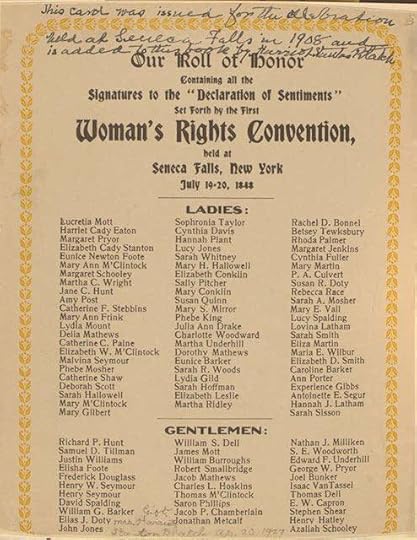
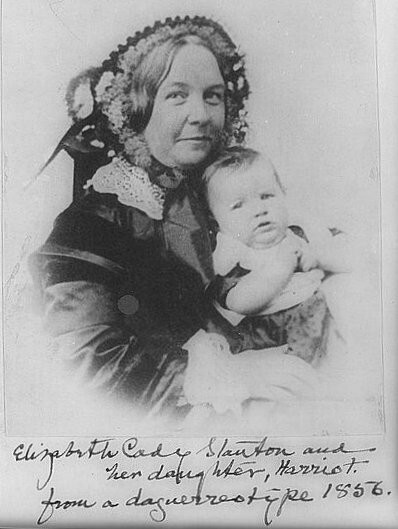
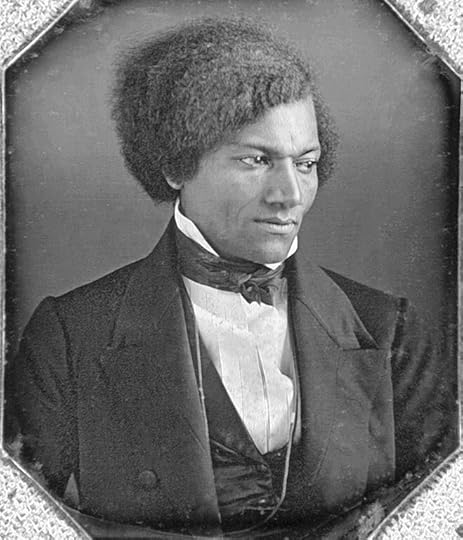
About 300 people – including 40 men who agreed to remain silent – came to the convention, organised by local Quaker women to call for women’s equality, including the right to vote and rights to property.
All the eleven declarations of the Convention were passed unanimously except for the resolution which demanded that women be given the right to vote. Those against this declaration feared it was too radical, and they would lose support for the whole Declaration by its inclusion.
In response, organiser Elizabeth Stanton was joined by the abolitionist Frederick Douglass, the only black person in attendance, who spoke powerfully in favour of women’s suffrage, and the resolution ultimately passed. 100 people — mostly women — signed the document. (Was your great great great great great grandparent one of them?)
Newspaper reports were mixed: The Oneida Whig wrote: ”This bolt is the most shocking and unnatural incident ever recorded in the history of womanity. If our ladies will insist on voting and legislating where, gentlemen will be our dinners and our elbows? Where our domestic firesides, the holes in our stockings?”
It would be a long path to equality — a further seventy-two years after the Seneca Falls Convention before American women achieved suffrage in 1920, and even then, it took four more years to be extended to Native American women and men, and it was not until 1966 that obstacles to African American voters were removed.
Images: Signatures to the “Declaration of Sentiments” via Wikimedia Commons. Elizabeth Cady Stanton and her daughter Harriot, from a daguerreotype, 1856, via Wikimedia Commons. Portrait of Ferderick Douglas, 1840s, via Wikimedia Commons.



Published on July 19, 2022 07:33
•
Tags:
on-this-day
May 17, 2022
Anne of Denmark
Today in 1590 Anne of Denmark, the delighted fifteen year old bride of king James VI, was crowned queen of Scotland. Still in their first year of marriage, the couple were by all accounts infatuated with each other – after Anne was prevented from sailing to England by bad weather, James had even travelled to Oslo himself as if he couldn’t wait any longer to marry her. The early romance did not last long and soon the couple found themselves frequently in disagreement. James later described marriage as “the greatest earthly felicitie or miserie, that can come to a man”.
Despite the urgent need for an heir, their first child Prince Henry was not born until 1594. What should have been a triumphant time for the new mother soon turned to horror when Anne discovered that James intended to follow tradition and place the baby Prince in the care of the Earl of Mar, 40 miles away from his mother. Desperate not to be separated from her first child, Anne furiously attempted to regain custody but James gave instructions that the baby was never to be surrendered to Anne, even upon James’ own death.
Grieving the separation from her son and then the loss of another baby, the marriage between Anne and James was irrevocably damaged and they began to live more separate lives. James did allow Anne’s younger sons to live with her, but she never stopped fighting to regain custody of Prince Henry. Finally, when James went south to claim the throne of England, Anne seized her chance. Pregnant with another son, Anne travelled to Stirling Castle to take her eldest son. The Earl of Mar’s wife held firm and refused. Anne, taking to her bed in fury and heartbreak, suffered another miscarriage.
Refusing to give up, Anne played her trump card, refusing James’ instruction that she join him in England as his Queen and insisting that she would only travel if she had custody of Prince Henry. Frustrated with her ‘froward womanly apprehensions’ and ‘wilfulness’ but knowing when he was beaten, James allowed Anne and Henry to travel together.
The young Prince Henry was popular and charismatic, charming, and handsome and there were great plans for him as a leader and future king. His sudden unexpected death from typhoid fever during the celebrations for his sister’s wedding, shocked the world. England and Scotland deeply mourned the loss of the eighteen-year-old prince and their hopes for his future kingship.
None mourned more than the mother who had fought so hard for her son. Henry’s death devastated Anne, and her own health deteriorated. As queen, she had always been a great patron of the arts and enjoyed putting on masques and plays, but after the loss of her son, Anne withdrew, and her life became more isolated. The husband who was so infatuated with her at the start of their marriage visited less and less frequently and it was her second son Charles who was with her as she finally succumbed to dropsy in 1619. She was buried at Westminster Abbey near to her beloved eldest son Henry.
Image: Anne of Denmark, by John De Critz the Elder, c.1605-1610, NPG 6918, © National Portrait Gallery, London
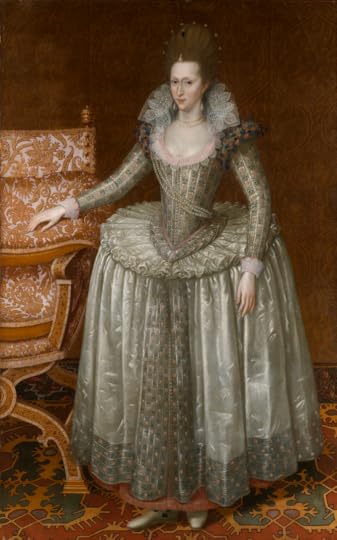
Despite the urgent need for an heir, their first child Prince Henry was not born until 1594. What should have been a triumphant time for the new mother soon turned to horror when Anne discovered that James intended to follow tradition and place the baby Prince in the care of the Earl of Mar, 40 miles away from his mother. Desperate not to be separated from her first child, Anne furiously attempted to regain custody but James gave instructions that the baby was never to be surrendered to Anne, even upon James’ own death.
Grieving the separation from her son and then the loss of another baby, the marriage between Anne and James was irrevocably damaged and they began to live more separate lives. James did allow Anne’s younger sons to live with her, but she never stopped fighting to regain custody of Prince Henry. Finally, when James went south to claim the throne of England, Anne seized her chance. Pregnant with another son, Anne travelled to Stirling Castle to take her eldest son. The Earl of Mar’s wife held firm and refused. Anne, taking to her bed in fury and heartbreak, suffered another miscarriage.
Refusing to give up, Anne played her trump card, refusing James’ instruction that she join him in England as his Queen and insisting that she would only travel if she had custody of Prince Henry. Frustrated with her ‘froward womanly apprehensions’ and ‘wilfulness’ but knowing when he was beaten, James allowed Anne and Henry to travel together.
The young Prince Henry was popular and charismatic, charming, and handsome and there were great plans for him as a leader and future king. His sudden unexpected death from typhoid fever during the celebrations for his sister’s wedding, shocked the world. England and Scotland deeply mourned the loss of the eighteen-year-old prince and their hopes for his future kingship.
None mourned more than the mother who had fought so hard for her son. Henry’s death devastated Anne, and her own health deteriorated. As queen, she had always been a great patron of the arts and enjoyed putting on masques and plays, but after the loss of her son, Anne withdrew, and her life became more isolated. The husband who was so infatuated with her at the start of their marriage visited less and less frequently and it was her second son Charles who was with her as she finally succumbed to dropsy in 1619. She was buried at Westminster Abbey near to her beloved eldest son Henry.
Image: Anne of Denmark, by John De Critz the Elder, c.1605-1610, NPG 6918, © National Portrait Gallery, London

Published on May 17, 2022 07:33
•
Tags:
on-this-day
April 29, 2022
Oxford allows women to sit examinations 1884
The University of Oxford – one of the oldest and most prestigious universities in the world – has been teaching men since 1096. But it took eight long centuries before Oxford allowed women to take examinations – 138 years ago today! Women were allowed to take the exams but not receive a degree. Only in 1920 were Oxford women finally recognised – and one of the graduates was this woman - Annie Rogers - who passed with first class honours 40 years before!
Image: Annie Rogers, by Lafayette, 1926, NPG x41479, © National Portrait Gallery, London
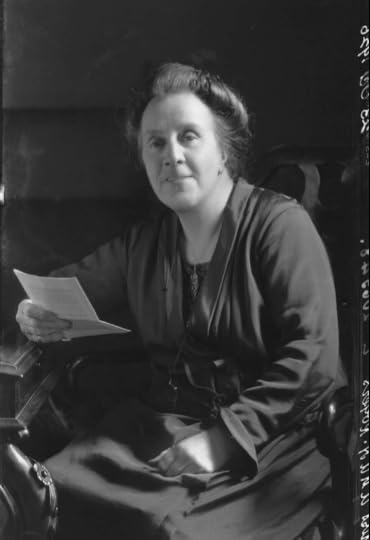
Image: Annie Rogers, by Lafayette, 1926, NPG x41479, © National Portrait Gallery, London

Published on April 29, 2022 08:10
•
Tags:
on-this-day
April 26, 2022
Sybil Ludington
Everyone knows the name Paul Revere – the rider who warned the American militia of the British advance in April 1775 – but who has heard of Sybil Ludington? The ‘Girl Revere’ aged only sixteen, who rode more than three times as far?
Paul Revere set off in darkness on a 12 mile ride to alert the American militia that the British forces were approaching in 1775. Revere and his two comrades were captured after raising the alarm. His ‘Midnight Ride’ became legendary, and a permanent addition to the history syllabus around the world.
Less famous is Sybil Ludington, the sixteen year old daughter of Colonel Henry Ludington, who prepared for battle and sent his daughter on a 40 mile ride through driving rain to alert the local militia at the town of Danbury – where munitions and supplies were stored – in April 1777. She used a stick to bang on the shutters of people’s homes, as she rode through town mustering the Colonel’s men.
There’s another story of her lighting candles around the family home and marching her siblings in front of the windows, to give the illusion that the house was well-guarded. These stories may be patriotic folk legends, but Sybil’s nephew certainly believed them in 1854 when he asked that his aunt be recognised at a ceremony for Revolutionary heroes, and the ride was recorded by historian Martha Lamb in 1880.
Heroine or not, Sybil Ludington died 26th February 1839 aged 77 in poverty, after she was denied a widow’s pension due to insufficient proof of marriage.
Images: Statue of Sybil Ludington by Anna Hyatt Huntington, via Wikimedia Commons. Sybil Ludington stamp, issued in 1975, via Wikimedia Commons.

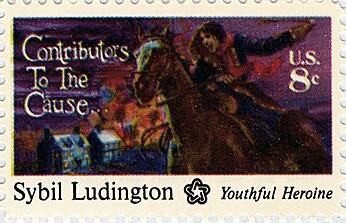
Paul Revere set off in darkness on a 12 mile ride to alert the American militia that the British forces were approaching in 1775. Revere and his two comrades were captured after raising the alarm. His ‘Midnight Ride’ became legendary, and a permanent addition to the history syllabus around the world.
Less famous is Sybil Ludington, the sixteen year old daughter of Colonel Henry Ludington, who prepared for battle and sent his daughter on a 40 mile ride through driving rain to alert the local militia at the town of Danbury – where munitions and supplies were stored – in April 1777. She used a stick to bang on the shutters of people’s homes, as she rode through town mustering the Colonel’s men.
There’s another story of her lighting candles around the family home and marching her siblings in front of the windows, to give the illusion that the house was well-guarded. These stories may be patriotic folk legends, but Sybil’s nephew certainly believed them in 1854 when he asked that his aunt be recognised at a ceremony for Revolutionary heroes, and the ride was recorded by historian Martha Lamb in 1880.
Heroine or not, Sybil Ludington died 26th February 1839 aged 77 in poverty, after she was denied a widow’s pension due to insufficient proof of marriage.
Images: Statue of Sybil Ludington by Anna Hyatt Huntington, via Wikimedia Commons. Sybil Ludington stamp, issued in 1975, via Wikimedia Commons.


Published on April 26, 2022 08:43
•
Tags:
on-this-day
April 23, 2022
Queen Anne crowned today in 1702
Today in 1702 Queen Anne, wearing crimson velvet over a jewelled robe and a petticoat trimmed with diamonds and gold and silver lace, was crowned queen of England, Scotland, Ireland and France. Anne was the second daughter of a second son, a rebel against her own father the king and enthralled by her women favourites. She was in chronically poor health, neither educated nor prepared for rule, yet, the House of Stuart was so divided by politics and religion, that Anne unexpectedly made it to the throne and would be one of the few popular Stuarts: the seventh and last.
The Stuart story starts with the most famous and glamorous Mary, Queen of Scots. Her son, James, took the English throne when his Tudor cousin Elizabeth I died without an heir. James I became an unpopular and combative king. His second son - the highly-strung Charles I - became heir on the death of his more talented elder brother Henry.
Charles I continued his father’s irritable relationship with parliament, imposing unjust taxes, and attempting an unsuccessful coup that prompted the English Civil war. The rise of Oliver Cromwell defeated Charles, and the hopelessly indecisive king was arrested, tried and executed. (My fictional Cromwell soldier, Ned, recounts the trial and execution in my novel, Tidelands.)
His heir, Charles II, was invited to return to the throne in the vacuum of power after Cromwell’s death. Glamorous, witty, wildly promiscuous, Charles II fathered many children, but no legitimate heir, so the crown passed to his brother James.
James II was a determined Catholic, married to a Catholic. When the couple announced the birth of a son - a Roman Catholic prince of Wales - there was uproar and a rebellion in favour of the nearest male Protestant - William of Orange, married to James’ oldest daughter Mary, who invaded in 1688. (I tell this story in my next novel, Dawnlands)
The co-rulers William III and Mary II accepted a political settlement that controlled the power of English kings. Mary was animated and popular, tall and beautiful, but after a series of miscarriages, she died of smallpox at just 32, without an heir. William ruled without her until his death and then the crown passed to Mary’s younger sister.
Which brings us to Anne. Unlike her sister, Anne was gout-ridden and short-sighted but had the luck to come to the throne at a time of military success, colonial expansion, and increasing wealth through trade – a real winner if you like that sort of thing. (Not everybody did or does). She combined the kingdoms into the United Kingdom of Great Britain and made Britain a major military power. Tragically, none of Anne’s many children survived to adulthood and the Stuart dynasty ended with her death aged only 49 in 1714.
Image: Queen Anne by Michael Dahl, c. 1705, NPG 6187
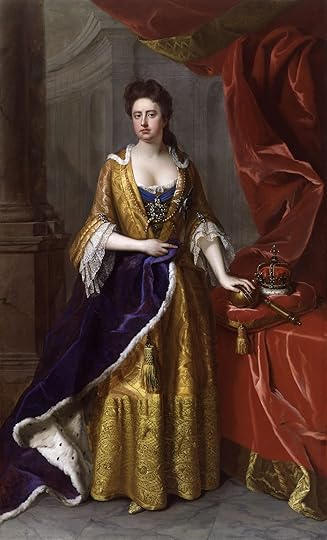
The Stuart story starts with the most famous and glamorous Mary, Queen of Scots. Her son, James, took the English throne when his Tudor cousin Elizabeth I died without an heir. James I became an unpopular and combative king. His second son - the highly-strung Charles I - became heir on the death of his more talented elder brother Henry.
Charles I continued his father’s irritable relationship with parliament, imposing unjust taxes, and attempting an unsuccessful coup that prompted the English Civil war. The rise of Oliver Cromwell defeated Charles, and the hopelessly indecisive king was arrested, tried and executed. (My fictional Cromwell soldier, Ned, recounts the trial and execution in my novel, Tidelands.)
His heir, Charles II, was invited to return to the throne in the vacuum of power after Cromwell’s death. Glamorous, witty, wildly promiscuous, Charles II fathered many children, but no legitimate heir, so the crown passed to his brother James.
James II was a determined Catholic, married to a Catholic. When the couple announced the birth of a son - a Roman Catholic prince of Wales - there was uproar and a rebellion in favour of the nearest male Protestant - William of Orange, married to James’ oldest daughter Mary, who invaded in 1688. (I tell this story in my next novel, Dawnlands)
The co-rulers William III and Mary II accepted a political settlement that controlled the power of English kings. Mary was animated and popular, tall and beautiful, but after a series of miscarriages, she died of smallpox at just 32, without an heir. William ruled without her until his death and then the crown passed to Mary’s younger sister.
Which brings us to Anne. Unlike her sister, Anne was gout-ridden and short-sighted but had the luck to come to the throne at a time of military success, colonial expansion, and increasing wealth through trade – a real winner if you like that sort of thing. (Not everybody did or does). She combined the kingdoms into the United Kingdom of Great Britain and made Britain a major military power. Tragically, none of Anne’s many children survived to adulthood and the Stuart dynasty ended with her death aged only 49 in 1714.
Image: Queen Anne by Michael Dahl, c. 1705, NPG 6187

Published on April 23, 2022 08:07
•
Tags:
on-this-day




